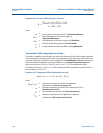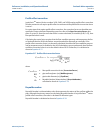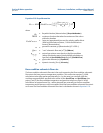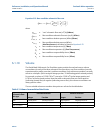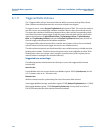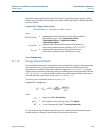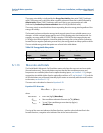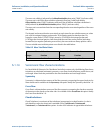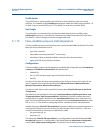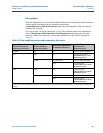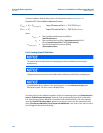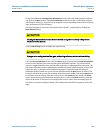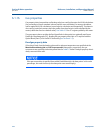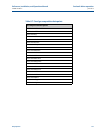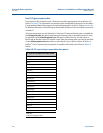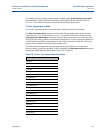
206 Flow-condition pressure and temperature
Section 6: Meter operation Reference, Installation, and Operations Manual
June 2013 3-9000-743 Rev S
Profile Factor
The profile factor is a dimensionless ratio of the inner chord velocities to the outer chord
velocities. It is readable via the ProfileFactor data point. Ideally the Profile Factor should be 1.0
for Dual-X meters (model 3422) and 1.17 for British Gas-style meters (model 3400).
Swirl angle
The swirl angle is an estimate of the swirl (to the nearest degree) and is readable via the
SwirlAngle data point. It is calculated as a function of the meter body style and Profile Factor
(see above). A value of 0 degrees indicates no appreciable swirl.
6.1.15 Flow-condition pressure and temperature
The flow-condition pressure and temperature are used by the Daniel Mark III Ultrasonic Gas Flow
Meter for various calculations such as
• expansion correction
• flow profile correction (JuniorSonic
™
meters only)
• calculation of base (standard) condition volumetric flow rate and volumes
• optional AGA10 sound velocity calculation
Configuration
The flow-condition pressure and temperature are individually configurable (via the EnablePres-
sureInput and EnableTemperatureInput data points) to be
• disabled (0),
• live (1) (4-20 mA input signal, requires the Option Board), or
• fixed (2).
If an input is live, then the values corresponding to the minimum and maximum input (4 and
20 mA, respectively) are specified via data points (MinInputPressure, MaxInputPressure,
MinInputTemperature, MaxInputTemperature).
If an input is fixed, then its value is specified via a data point (SpecFlowPressure, SpecFlow-
Temperature).
Alarm limits can be specified for each input (LowPressureAlarm, HighPressureAlarm, Low-
TemperatureAlarm, HighTemperatureAlarm). Additionally, the flow-condition pressure is
configurable to be gage or absolute (via the InputPressureUnit data point). If the pressure is
gage, then the atmospheric pressure must be specified (via the AtmosphericPress data point).
See Section 5.6.12 for details on configuring the flow-condition pressure and temperature.
Another data point (FlowPOrTSrcUponAlarm), common to both pressure and temperature, is
used to specify the data source to use when the selected input data is invalid (i.e., value at or
outside its alarm limits or a live input in calibration) as either
• last good value (0), or
• fixed value (1).
This data point (FlowPOrTSrcUponAlarm) is not configurable via the Daniel MeterLink
Field
Setup Wizard
; however, it is configurable via the Daniel MeterLink Edit/Compare Configuration
screen (
Tools→Edit/Compare Configuration). The default is to use the last good value.



